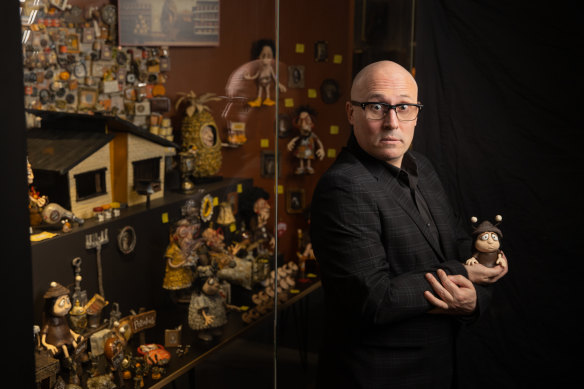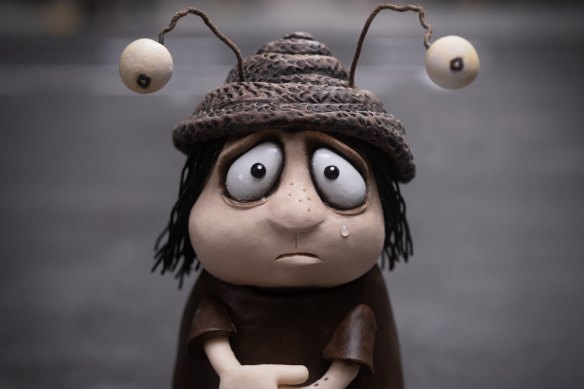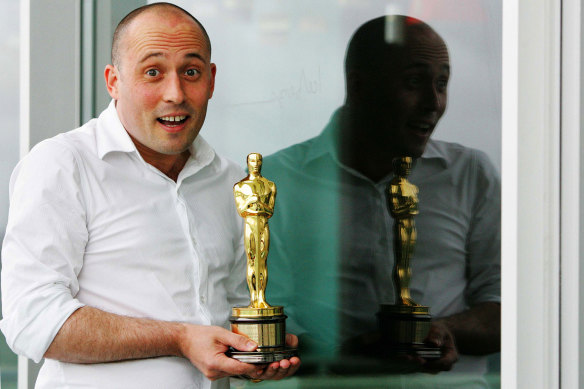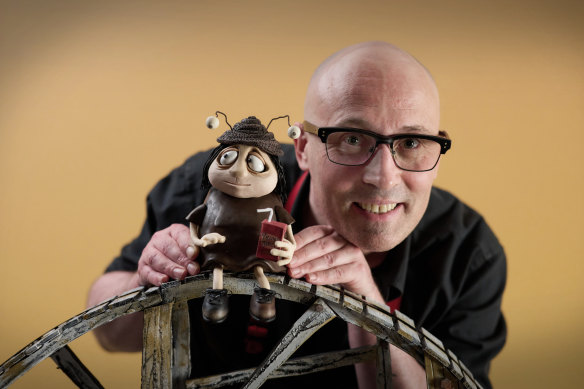Memoir of a reluctant animator: Adam Elliot’s long road to success
The Oscar-winning filmmaker’s Memoir of a Snail has landed 15 years after his last one. Such is the nature of stop-motion animation.
By Karl Quinn

Adam Elliot in front of one of the sets from Memoir of a Snail, on display at ACMI.Credit: Simon Schluter
Had he taken the number 1 tram as planned, Adam Elliot might never have ended up winning an Oscar and becoming the most acclaimed practitioner of claymation in the country. (OK, it’s a shallow pool: his second feature, Memoir of a Snail, is “only the third stop-motion feature ever made in Australia”, he says. His first, Mary and Max, became the second when it was released 15 years ago.)
It was 1996, and Elliot had applied for the one-year post-graduate diploma in animation at the Victorian College of the Arts, despite having no degree to his name. After five years hand-painting and selling T-shirts at the St Kilda Market, he’d had enough and knew it was time for a change.
But he had a back-up plan, just in case. “I applied for a picture-framing course at the CAE,” he recalls. “I love photography, I was sick of T-shirts, I thought maybe I could frame my own photos because that’s still a big thing down at the craft market.”
At the VCA, he was interviewed by Sarah Watt – the late animator, filmmaker and wife of actor William McInnes – and did terribly.
“I didn’t get in, so I thought, ‘all right, I’ll do picture-frame making’. And then on the first evening, as I got ready to get the number 1 tram there, the phone rang, and it was the administrator of the VCA. She said, ‘Adam, even though your interview didn’t go very well, one of the eight students has dropped out, and we have a waiting list, and we really liked your T-shirts. Do you still want to do the animation course?’”

Grace Pudl, the narrator and main character of Memoir of a Snail.Credit: Madman
A no-brainer, you’d think. “But I said, ‘Oh, that’s fantastic, but I’m just on my way to a picture-frame making course. I’m not sure I’ll get my $50 deposit back’.”
Even after he’d thrown caution – and his deposit – to the wind, Elliot didn’t immediately find his way to the field of animation in which figures are manipulated and photographed one frame at a time to create the illusion of movement.
“I didn’t want to do stop-motion,” he says. “It was only towards the end of the course that the lecturers said, ‘We think you should do stop-motion because your dad owns a hardware shop and you can get all the materials cheap’.”
Elliot tells me this story – and he shares it with students when he does guest lectures, too – “because it just shows that sometimes you are in the right place at the right time, and you don’t have to have this burning ambition or a 10-year plan”.
Still, in the field he chose – or which, perhaps, chose him – playing the long game is unavoidable.
Elliot arrived in the public consciousness seemingly fully formed when he won the 2004 Oscar for best animated short with Harvie Krumpet. It opened doors for him, of course, because suddenly “people have more faith in you and think you know what you’re doing”. But there’s a slight flipside too. “I remember when we won it, my dad said, ‘Well, it’s all downhill from here, you’ve got nothing left to aim for now’. Thanks Dad. But in some ways, it’s good to get that out of the way.”
It certainly helped get his first feature made. But when Mary and Max disappointed at the box office, getting the second one up proved incredibly difficult.
“Mary and Max was $8 million,” he says. “This is only $7 million, so with inflation it’s almost half of what Mary and Max was. That’s why there’s no walking in the film, it’s why there’s no fabric in the film. We had to do all this R&D to try and work out how we were going to get the budget down.”
As we talk, Elliot is fiddling with a small clay puppet of his film’s central character, Grace Pudel. Standing maybe 10 centimetres high, crafted of plasticine over a metal armature, with magnetic eyes that can be repositioned to suggest a wide variety of emotional states – “lip sync is expensive, whereas it’s very cheap to move that pupil around” – the figure cost, he estimates, about $10,000 in labour hours to craft. And there are another 200 of them in his film.

Elliot with his Oscar for Harvie Krumpet in 2004.Credit: Jenny Evans
The story is narrated by Grace (voiced by Succession star Sarah Snook), a twin born with a hare lip, who develops a fascination with snails; something about the way they build up a hard protective outer layer resonates with her. Her life is one of loneliness, punctuated by acute moments of loss: the disappearance of her brother Gilbert (Kodi-Smit McPhee), the death of her clown father Percy (Dominique Pinon) and her eccentric neighbour Pinky (Jacki Weaver), the disappointment of her marriages to Bill (Nick Cave) and Ken (Tony Armstrong).
Memoir of a Snail has deaths, arson, swingers’ parties, gay conversion therapy, disability. It’s glum and funny and, ultimately, beautifully uplifting. Little wonder it won the Cristal Award at Annecy, the world’s most prestigious animation showcase, in June, making Elliot the first person ever to win the French festival’s top prize twice.
“It’s probably the happiest ending I’ve ever had,” he says. “Somebody said years ago ‘without the dark, the light has no meaning’, and that really struck a chord with me. I used to be self-conscious of doing too much darkness, but I think now I’m in my 50s, I’m not confident, but I’m prepared to take bigger risks. I think it’s a writer and director’s job to push the boundaries, particularly in stop-motion, to do stuff that no one else is doing.”
Elliot doesn’t actually animate any more – “I’ve got this shake I was born with, a physiological tremor” – and says if he could choose to do anything with his time it would be drawing. “I’d give up filmmaking tomorrow if I could just spend the rest of my life drawing, because it’s easy,” he says. “You’re just in a room, it costs nothing, it’s just me and I don’t have to collaborate or raise money. Truly.”
To write, he says, “I have to be angry about something – or not angry, but I have to have a sense of injustice.”
The spur for Memoir was the death of his father, who had been a vaudevillian and clown. “He was a collector/hoarder, as is Mum, who’s still alive, and my brothers and my sister and I were trawling through all the stuff, and I was really angry with him for dying and also for having all this hoard,” says Elliot. “So I became frustrated, and then that turned to fascination, and then I started reading up on the psychology of hoarding. And it became really interesting, because most severe or extreme hoarders have suffered some degree of trauma, and that’s why they collect. Everything they give a sentimental value and a meaning, and that’s why they just can’t throw anything out.”

Elliot and Grace.
Elliot is not immune to the impulse himself. Trawling through old journals, he came across notes he had written 30 years earlier “about a friend of mine who was born with a severe cleft palate, and she wanted me to make a short film about her life, and I never did. But I started rereading the notes, and it was all these details about how traumatic her childhood was and the bullying, she had a dozen operations on her lip, she was pretty severe. But now she’s this extrovert, very flamboyant fashion designer. And I was just like, ‘how does someone transform from this bullied little shy girl into this flower?’ So there’s those two ideas, and they just gradually came together.”
He storyboarded every shot in the film during lockdown, hand-drawing the frames that would eventually be recreated in plasticine. Many of those sketches, and some sets and props, are now on display at ACMI; an exhibition of his drawings will open at the end of the month at Beinart Gallery in Brunswick.
“COVID was fantastic, I had a great time,” he says. “I loved it, because the film got so developed, it was so ready to go. By the time we finally got that money, I had drawn everything, every production design was done. I feel this film’s probably the most polished one I’ve done, and it’s thanks to COVID.”
The incredibly long gestation of Memoir of a Snail has brought some unexpected benefits. It is hitting cinemas at a moment when Snook’s name is a real draw, and stop-motion is suddenly in vogue, in part perhaps, as a reaction to the rise of AI.
“This handmade look is really in at the moment, which is great for me,” says Elliot, who is determined we won’t have to wait another 15 years for his third feature.
“I’ve already got the idea for the next one,” says our most successful, and reluctant, animator. “You’ve got to strike while the iron’s hot, while there’s interest.”
Memoir of a Snail is in cinemas from October 17. The Making of Memoir of a Snail exhibition is at ACMI. Adam Elliot’s drawings are on display at Beinart Gallery from October 26 to November 17.